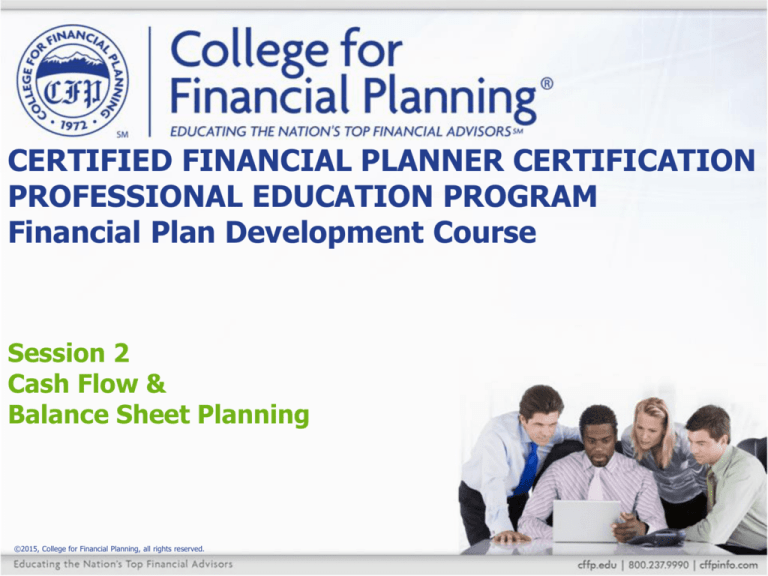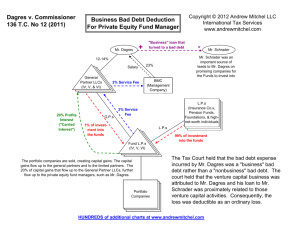
CERTIFIED FINANCIAL PLANNER CERTIFICATION
PROFESSIONAL EDUCATION PROGRAM
Financial Plan Development Course
Session 2
Cash Flow &
Balance Sheet Planning
©2015, College for Financial Planning, all rights reserved.
Start Recording
This class is being
recorded so you may
review it at a future
time.
2-2
Get to Know David & Nancy
Appendix A – pp. 127–129 (easier to read)
•
•
•
•
What is important here?
What are the goals?
What analysis do we need to do?
How does this conflict with your values?
2-3
David & Nancy continued
pp. 128-129
2-4
Developing the Scope of Engagement
To develop our scope of engagement, define their goals:
• You would like assistance in creating an efficient strategy for
managing current debt.
• You want all debt paid off prior to retirement.
• Other than college loans and Autumn’s car at graduation, you do
not see any additional expenses in the next five years that cannot
be met by current budgeted expenses.
• Only potential issue is that you are worried you may need to
replace deck but hope you can postpone or use possible stock
option if needed (3-year vesting, up to 20% of salary).
• You would like advice on how to balance investing, debt reduction,
and college within current budget constraints.
• Prior to unemployment, you had three months of reserves but
would like to build six months.
2-5
The Financial Planning Process
Systematic Financial Planning
Establish &
Define the Relationship
EGAD I’M … going to pass!
Know each step and
parts of each step!
Gather Data &
Frame Goals and Objectives
Analyze & Evaluate the Client’s
Financial Status
Analyze Current Situation
Determine and Quantify the
Planning Needs
Document and Evaluate Current
Planning Efforts
Review Prospective Planning
Strategies
Develop Client-based
Recommendations
· Identify and Select Best
Strategies to Meet Need
· Frame Recommendation Into:
Who, What, When, Where,
Why, How and How Much
Develop Comprehensive Plan &
Present Recommendations
Implement the Plan
Monitor the Plan, Implementation,
& Goal Progress
2-6
Dudella Net Worth Statement
Analysis on David & Nancy:
• What stands out to you?
• What is your process for
tracking potential
issues?
2-7
Dudella Current Cash Flow
2-8
After Data Organization
•
•
•
•
•
•
•
•
Once you have organized and audited data, apply brain!
What broad issues do you see?
What issues could devastate the clients’ financial security?
What efficiency issues do you see?
What can’t you tell until you do more analysis?
What additional information is needed?
Where are the clients’ blind spots and what will they ignore that
you need to help them see?
Software is good for analyzing the large issues (e.g., goal
achievement and some risk assessment). It doesn’t identify details
causing problems (e.g., efficiency strategies, tax and cash flow
consequences); that’s the planner’s job.
2-9
Cash Flow Analysis
You must start with what funds your client has easily available that
you can work with and track as you go.
My Clients - Dudellas
Your Clients - Dowlers
Did not save during past two years
After-tax savings you can
reallocate:
Now have $24,000 to reallocate:
Annual tax refunds or changed
withholding available to reallocate to
meet goals:
$5,000
$9,900
First year only inheritance: $5,500
Tax Refund this year:
$5,600
Starting point:
$24,000
Starting Point:
$26,000
After 1st year:
$24,000
After 1st year:
$14,900
2-10
Enough money?
Dudella Potential Issues*
• Education
• Car
• Retirement (David’s match?)
• Debt restructure and
repayment
• 5 yr. ARM paid off by
retirement
• Emergency funds
• Life insurance
• Disability
• P&C
• Investment management
• Estate & legal documents
* from the scope of engagement client letter
Dowler Potential Issues
• What will you be addressing?
In both cases, you won’t know if
there is enough money to
accomplish goals until the issues,
potential solutions, and costs are
analyzed.
2-11
Emergency Reserves
What should you suggest:
• Target: somewhere between 3–6 months
• Vehicle: taxable, after tax, etc.
• Timing: 1 year–3 years to complete?
How will it impact cash flow:
• Advantages,
disadvantages,
alternatives
• How do you prioritize?
2-12
Dudella Emergency Reserves
pp. 143-144
2-13
Dowler Emergency Reserves
Include discussion of having Roth contributions in money market until
reserves reach six months then shifting.
2-14
Dowler Emergency Reserves
•
•
•
•
•
Would your client
understand the issue and
consequence of not
addressing?
Is the recommendation clear
and actionable?
Do the advantages and
disadvantages give the
client enough information to
make an informed decision?
Is the alternative a realistic
one?
This is from your executive
summary. You might decide
to change it; what would
influence your decision?
2-15
Debt Management
Dudellas’ Calculations
Dowlers’ Calculations
Nonmortgage debt-to-income:
(Annual nonmortgage MINIMUM
payments/Annual Net Income)
$19,356/$110,202 = 17.56%
What did you get?
Front-end ratio: (PITI/Gross Income)
$14,232 (PI) + $3,708 (Taxes) + $1,284
(Ins.) = $19,224/$156,172 = 12.31%
Front-end ratio?
Back-end ratio: (all debt/Gross Income)
($19,356 + $19,224) = $38,580/$156,172
= 24.7%
Back-end ratio?
These are favorable, but short employment
time makes refinancing unfavorable.
How do Dowlers stand compared to rules of
thumb? Favorable or unfavorable
refinancing opportunities?
Nonmortgage debt to income?
Debt Management Rule of Thumb
Nonmortgage debt-to-income ratio 20% or less of net monthly income
Front-end ratio
28% or less of gross monthly income
Back-end ratio
36% or less of gross monthly income
2-16
Possible Debt Strategy: Dudellas
Consider: using home equity line to restructure
more expensive debt (credit cards).
Advantages
• Current home equity lines are around 4% and would be tax
deductible. High loan-to-value loans are closer to 8%. You
could keep the same payments and pay off debt much
faster.
Disadvantages
• Existing loan is less than 20% equity and may not be
able to qualify with $20,000 by last projection and debt
balance is higher. If 10% increase, then equity balance
would be $46,062. Could be used for a portion of the
debt and look for alternatives for the balance.
2-17
Possible Debt Strategy
Consider: Roll part of old 401(k) into new company
and take 5-year loan to pay off credit card debt.
Advantages
• Current loan rate is 5.5% and you are paying yourself.
• Will free up $13,328 cash flow.
• Removes debt from your credit reports and improves your
credit score, which could be beneficial in refinancing mortgage.
Disadvantages
• If you leave the company, the entire amount is taxable income
in the year of the event. You jeopardize funds earmarked for
retirement. Your asset allocation would be impacted. If a crisis
occurs, you could have declared bankruptcy and kept funds.
2-18
Possible Debt Strategy
Consider looking for lower interest rate credit cards. You may now be
eligible for some 0% or low introductory rates for 12 months and
transfer any balances that you can pay off in that 12-month period or
be prepared to restructure debt again in one year.
Advantages
• You may be able to transfer at least $9,000 to cards with
very low rates and save considerable interest.
Disadvantages
• If you do not pay the debt off on time, the entire balance
could be charged at the highest rate. Opening another
card or transferring may impact your credit score. You will
most likely need additional student loans that could
impact your rate.
2-19
Preparing the Recommendation
What else do you need to know before recommending?
• Any calculations to do?
•
•
Any information to gather?
What will you recommend?
I chose 401(k) option, reasons:
• Credit score impact to help mortgage
refinance
•
They are not clients who will rebuild debt if
cash flow is freed up unless he loses his job
(they would have to tap into qualified
plans anyway)
•
•
•
They receive interest
Education costs will be adding to debt
Lots of other issues to address with cash flow
2-20
Specific Recommendations (Draft)
Recommendation
•
Your next three years will require significant outflows as you fund college.
I recommend you acquire a 401(k) loan for these credit card balances
utilizing a 5-year repayment plan. Once college funding has been
accomplished, you can quickly retire this debt. When options vest, use to
pay off 401(k) debt and fund reserves.
•
Advantages: Your account will be credited with the interest you are
paying less administrative fee. Your payments will be $630, which will
increase cash flow $1,332. Your credit score will improve, which could help
with refinancing and student loan rates.
•
Disadvantages: If you leave the company, the entire amount is taxable
income in the year of the event. You jeopardize funds earmarked for
retirement. Your asset allocation would be impacted. If a crisis occurs, you
could have declared bankruptcy and kept funds.
•
Alternatives: Look for lower credit card rates and combine with use of
home equity line when you qualify.
2-21
Think Through Impact
Use 401(k) loan to pay off credit cards
2-22
Your Turn – Dowler Debt?
What would improve their cash flow and long-term
position?
2-23
Mortgage
Dudella mortgage
Dowler mortgage
• 5-year adjustable rate mortgage (since
• Higher than current rates
• Great credit score and long employment
rates are expected to increase above
current levels)
• Refinancing to a fixed loan may not be
possible due to current debt, although
debt ratio is within acceptable ranges.
Rules are more strict and credit costs
higher if ratio is close.
history
• Have cash to pay closing costs if desired
and first month’s expenses
Want your advice on which option to
take
• Home values have increased this year
and maybe up 10% since they last
checked value. They may meet 20%
equity requirement. Need closing costs
from bank and 1-2 years’ income
history.
Address this now or add to
agenda/discussion for within a year
when they will have built reserves
and/or moved or paid down debt?
2-24
Are your calculations right?
2-25
Track Cash Flow as You Go
Try different combinations
May shift emergency fund build up to front load and then reduce in 2015, but still lots of issues
to address and not sure about cash flow yet. Year 2016 has problem and would not pass!
2-26
Dowler Cash Flow So Far:
• Your total may be different from other students’ due the
•
•
mortgage selected.
You may change
your mind about
the mortgage by
the end of class.
You may change
emergency
reserves too!
2-27
Savings Ratios
Dudellas
Dowlers
David’s 401(k):
$3,603
David’s employer match:
$3,603
David’s stock purchase:
$3,603
Nancy’s 401(k):
$ 900
Nancy’s employer match: $ 900
Total:
$12,609
$156,172
Savings ratio:
8.07%
Total:
Total income:
?
$152,196
2-28
Next Class
Prior to next class
Read
Risk
Management,
pp. 35–41
Complete Plan
Development
Boxes 6- 8
Homeowners, p. 37
Auto coverage, p. 39
Umbrella coverage, p. 41
2-29
CERTIFIED FINANCIAL PLANNER CERTIFICATION
PROFESSIONAL EDUCATION PROGRAM
Financial Plan Development Course
Session 2
End of slides
©2015, College for Financial Planning, all rights reserved.






